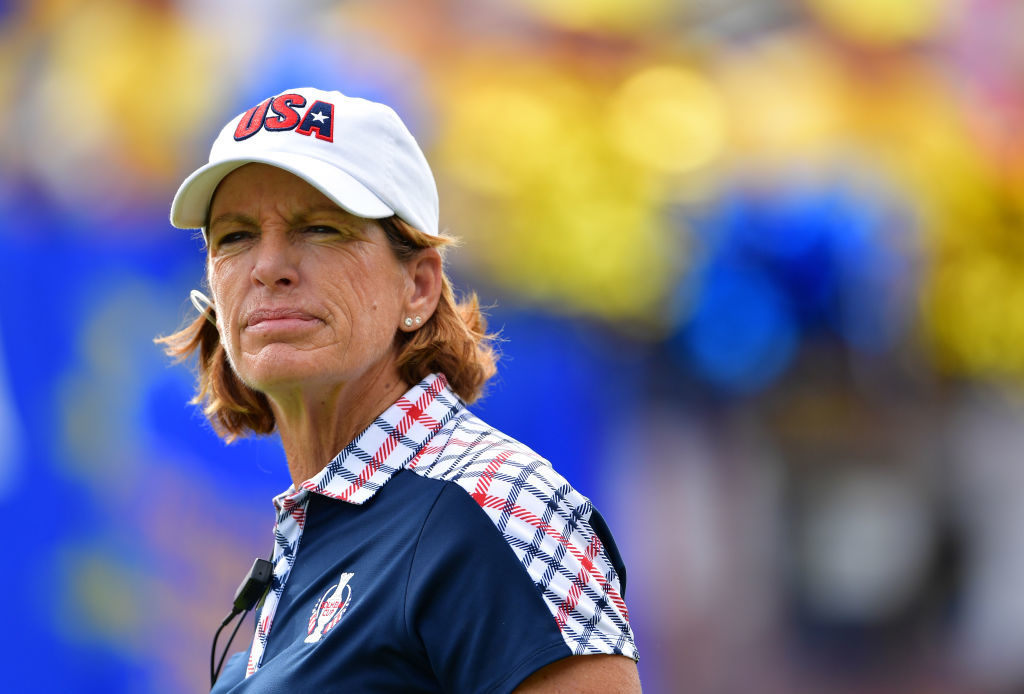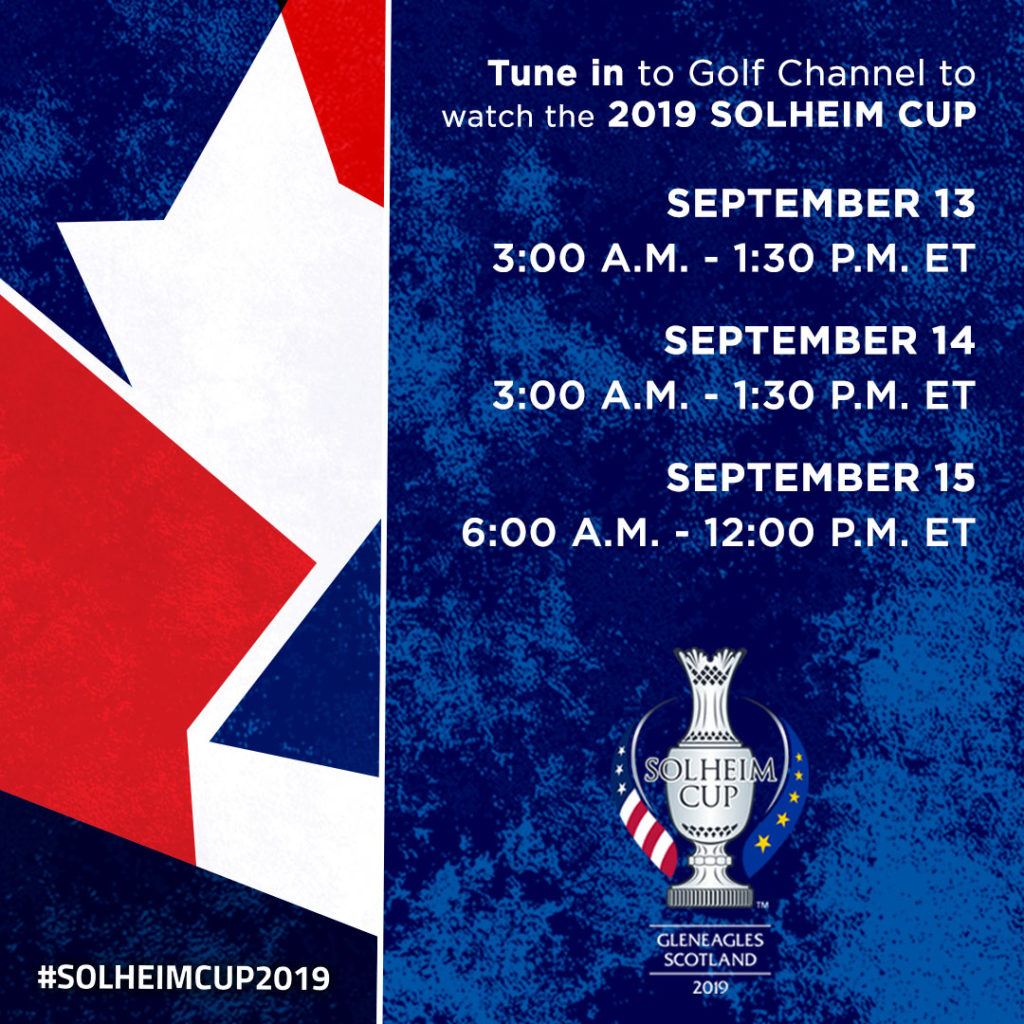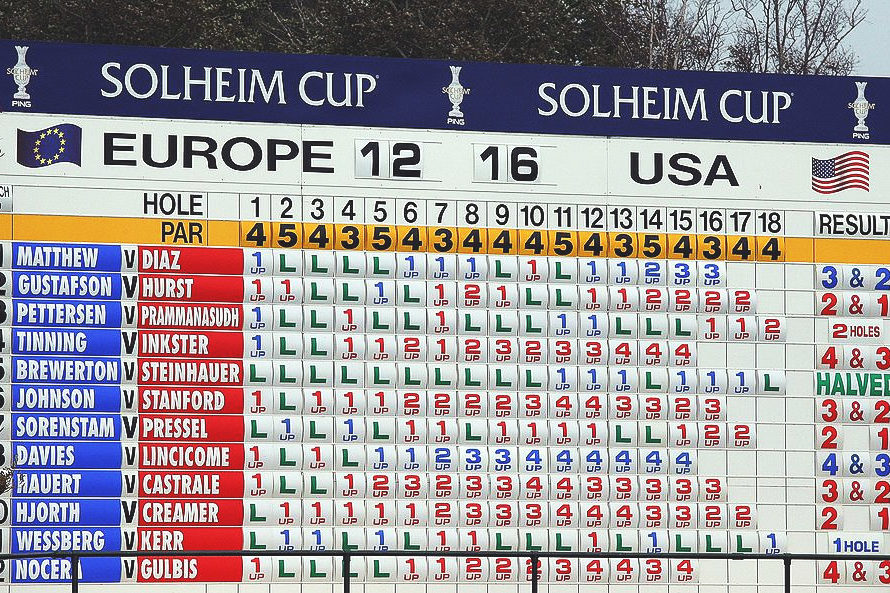In stroke play, scoring is easy: Just add the total strokes taken by each player and at the end of the round the winner is the player (or team) with the fewest number of strokes.
The Solheim Cup, however, is a match-play competition. In match play, think of each hole as a head-to-head match that may be either won, lost or tied. This unique tournament takes match play one step further, utilizing three different match-play formats: Fourballs, Alternate Shot and Singles.
You won’t see the typical number of strokes under par that you’re used to on a standard stroke-play tournament’s leaderboard. Players for Team USA and Team Europe will have the opportunity to win a point for their team for a win and a half-point for a tie.
The scoreboard will only indicate what player is “UP” by whatever number of holes won, or “ALL SQUARE” if the match is tied. Each tied hole is said to be “HALVED,” and if the match ends tied, the match is also HALVED. You’re likely to also see something like “2&1,” meaning 2 holes won with one more to play or even just the name of the team with a lead.
Helpful Match-Play Terms to Know
Match Play has its own vocabulary. These are a few of the terms which are helpful to know before turning into the Solheim Cup:
“Dormie” is another term you might hear. The term is unique to match play and refers to the player (or a partnership) that has to win every remaining hole to avoid losing the match.
For example: If a player or partnership is “Dormie” on the 16th tee with three holes left to play, the best the dormied player can hope to do is win every remaining hole to “halve” the match. The non-dormie player wants to win or tie at least one of the holes and win the match. That scenario is very exciting in the Solheim Cup and often where you can feel the players reaching into themselves for their best shots.
“Concession”
Conceding a putt or a hole is when an opponent “gives” the shot to her opponent as if the shot had been holed. This will usually occur on short putts where one player says, “that’s good,” or “pick it up.”
Sometimes, as happened frequently in the Junior Solheim Cup on Tuesday, the player giving the concession will pick up their opponent’s ball and hand it to them, a courteous gesture.

Lizette Salas holes the winning putt on the 18th hole during the Solheim Cup at Des Moines Golf and Country Club. (Photo by Stuart Franklin/Getty Images)
Now for the Scoring and Pairings
Team USA will need 14 total points to win the Solheim Cup and keep it in the US while team Europe will need 14-1/2 points to win and bring the Cup back to Europe in 2019.
- Day One: 4 Foursomes in the morning and 4 Fourballs in afternoon
- Day Two: 4 Foursomes in the morning and 4 Fourballs in the afternoon
- Day Three: Singles — 12 matches (all players must play)
On Day One and Day Two four players on each Team sit out which means there are important Captain’s decisions to be made as to who plays.
Each Captain prepares her roster of players for each day not knowing the order the other Captain has selected. Both Captains carefully review the stats and strengths of the players on both teams but at the end of the day, the matchups are very much a guessing game!

Juli Inkster, Captain of Team USA looks on during the final day singles matches of The Solheim Cup at Des Moines Golf and Country Club. (Photo by Stuart Franklin/Getty Images)
If you’re like me, you’ll be watching for each team’s approach to grouping its players during each round along with the great play happening on the course while players are under pressure. You can find the TV times for the Solheim Cup which will be broadcasted on The Golf Channel here:

And for some added fun, LPGA player Brittany Lincicome will be hosting a watch party during Saturday’s matches from 7:30am – 1:30pm ET on Twitter. You can use the hashtag #SolheimWatchParty to join in on the conversation and ask Brittany questions!
I absolutely love the Solheim Cup and will have the pleasure of watching the action live in Scotland this year. Check back here for more of my updates throughout the week!

This format is also used in the Ryder Cup. Before 1996, and also in 2000, the Solheim Cup used a similar, but abbreviated format.